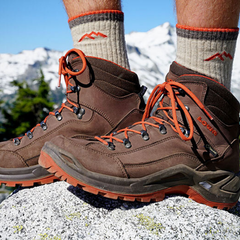How to find the best hiking boots for your needs?
Spring is here and the mountains await us. Perhaps you are due to renew your pair of hiking boots. These days, there are so many choices that it can be difficult to find the right one for you and your needs. That's why we've brought you this buying guide so you can make a sustainable choice that best meets your backpacking needs.
There are 2 main categories in hiking footwear: either the shoes where the walking boots. We will show you the advantages and disadvantages of each as well as their main use.
Walking shoes
Activities: We recommend it for day hikes or light hikes on easy terrain with minimal load on the back.
Advantages: Lightweight and flexible
Disadvantages: Does not provide optimal ankle support and is not recommended for long distances.
Walking boots
Semi-rigid
Activities: We recommend it for people with weak ankles who want a little more support. It is perfect for light to medium treks over short to medium distances.
Benefits :Better ankle support. The sole is more rigid.
Disadvantages: A little heavier and less flexible than shoes.
Rigid Walking Boots
Activities: We recommend it for people who go hiking for several days over longer distances, in steep terrain with a load on their back. It is perfect for long hikes.
Benefits :Excellent support for the ankles, can be carried with a heavy load over long distances since the shank is more rigid.
Disadvantages: Heavier than the semi-rigid boot.

Features to consider when buying a hiking shoe
Equipment
There are different materials that make up hiking shoes or boots. Here are the main ones:
- Leather: Leather is extremely comfortable, water resistant and breathable. This is the best choice if you want a shoe for the long haul. Leather requires a little more maintenance than a synthetic boot. You will need to treat it to re-waterproof and rehydrate each season to make sure it is waterproof. On the other hand, leather will be heavier and more expensive.
- Synthetic Fabrics: Synthetic polyurethane materials are generally lightweight, breathable and dry in no time. This material is also less expensive than leather. However, it will be less water resistant and durable in the long run.
- Waterproof-breathable membrane: Every company that makes hiking boots offers an in-house waterproof breathable membrane or Gore-Tex to ensure the boot's waterproofness without compromising their breathability TOO MUCH. This membrane will prevent water from entering the boot, but will allow the moisture inside to escape quickly.
The shoe size
It's important to make sure you choose the right size if you don't want to injure yourself on long rides.
Since shoe sizes vary from company to company, it is important to try on the boot. During the test, make sure that your toes are not touching the tip of the boot. The goal is to protect your toes during the descent. Your heel should rise slightly when going up or down. You can still simulate an ascent on a staircase in a store or on the demonstration slope. When removing the sole of the shoe, while standing, you should have 1 to 2 finger widths of distance from the end of the sole again to prevent your toes from hitting the end of the boot.
The width
From company to company, boots vary in width. There are some models that are designed for wide, regular or narrow feet. For example, the company Keen is known for offering wide shoes and boots. While a company like Lowa designs shoes for narrower feet. Your choice of boot width can vary depending on how you use it. If you need a hiking boot that will give you more precision on the approach, a narrower boot will be ideal. Employees in the store can help you with these kinds of more detailed details.
Pro tips: Are we going for a hike?
- It is important to assess what type of shoe you will need for your intended use so that they actually meet your needs.
- When trying on hiking boots be sure to wear thicker or thinner merino wool socks to get the best possible idea of the boot's fit and comfort.
- Try on the boots at the end of the day when your feet are a little swollen. This will give you a more realistic idea of the fit of the boot.
- If you wear orthotics, bring them when you try them on.
- Wear the boots for a few minutes in the store to give yourself the chance to feel any glaring discomfort in the boot. If you come to the store, we will have you try the boots on steps and on a demo slope.
Our in-store policy: you have 10 days to try on the boots at home. You try them at home for a longer period. If after reflection, they seem uncomfortable, you can take them back to the store and we will reimburse them. They must have been worn ONLY inside, have the original tags and be clean.
The Plein Air Entrepôt team is available and trained to help you find THE shoe you need to accompany you on your mountain adventures in absolute comfort. Come see us !

